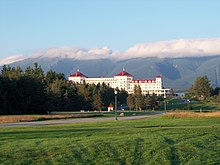
Embedded liberalism is a term in international political economy for the global economic system and the associated international political orientation as they existed from the end of World War II to the 1970s. The system was set up to support a combination of free trade with the freedom for states to enhance their provision of welfare and to regulate their economies to reduce unemployment. The term was first used by the American political scientist John Ruggie in 1982.[1]
Mainstream scholars generally describe embedded liberalism as involving a compromise between two desirable but partially conflicting objectives. The first objective was to revive free trade. Before World War I, international trade formed a large portion of global GDP, but the classical liberal order which supported it had been damaged by war and by the Great Depression of the 1930s. The second objective was to allow national governments the freedom to provide generous welfare programmes and to intervene in their economies to maintain full employment.[2] This second objective was considered to be incompatible with a full return to the free market system as it had existed in the late 19th century—mainly because with a free market in international capital, investors could easily withdraw money from nations that tried to implement interventionist and redistributive policies.[3]
The resulting compromise was embodied in the Bretton Woods system, which was launched at the end of World War II. The system was liberal[4] in that it aimed to set up an open system of international trade in goods and services, facilitated by semi-fixed exchange rates. Yet it also aimed to embed market forces into a framework where they could be regulated by national governments, with states able to control international capital flows by means of capital controls, as well as engage in state-led development strategies, short-term IMF borrowing, and exchange rate adjustments.[5] New global multilateral institutions were created to support the new framework, such as the World Bank and the International Monetary Fund.
When Ruggie coined the phrase embedded liberalism, he was building on earlier work by Karl Polanyi, who had introduced the concept of markets becoming disembedded from society during the 19th century. Polanyi went on to propose that the reembedding of markets would be a central task for the architects of the post war world order and this was largely enacted as a result of the Bretton Woods Conference.[6] In the 1950s and 1960s, the global economy prospered under embedded liberalism, with growth more rapid than before or since, yet the system was to break down in the 1970s. Ruggie's work on embedded liberalism rebutted hegemonic stability theory (the notion that a hegemon is necessary to sustain multilateral cooperation) by arguing that the international order was not just maintained through material power but "with legitimate social purpose".[7]
- ^ Ruggie, John Gerard (1982). "International Regimes, Transactions, and Change: Embedded Liberalism in the Postwar Economic Order". International Organization. 36 (2): 379–415. doi:10.1017/S0020818300018993. ISSN 0020-8183. JSTOR 2706527. S2CID 36120313.
- ^ As World War II was drawing to a close, there was more political support for redistributive policies than ever before. The working classes had increased influence due to the recent expansion of the electoral franchise and the wealthier classes were generally more sympathetic due to the shared experience of participating in the war and as moderate Keynesian policies were seen as the best measure to stabilise liberal democracy by reducing poverty and unemployment, thus forestalling the rise of extremists such as fascists.
- ^ This had recently happened to France after the Popular Front came to power in 1936. As Keynes said at the Bretton Woods Conference: "Surely in the post-war years there is hardly a country in which we ought not to expect keen political discussions affecting the position of the wealthier classes and the treatment of private property. If so, there will be a number of people constantly taking fright because they think that the degree of leftism in one country looks for the time being likely to be greater than somewhere else". Quoted in Helleiner (1995) at p. 35.
- ^ The word liberal has a special meaning here and should not be confused with the modern United States sense of the word which can be associated with left-leaning politics. As is common in most international political economy topics, the word in this article generally means supportive of free trade.
- ^ Helleiner, Eric (2019). "The life and times of embedded liberalism: legacies and innovations since Bretton Woods". Review of International Political Economy. 26 (6): 1112–1135. doi:10.1080/09692290.2019.1607767. ISSN 0969-2290. S2CID 198646716.
- ^ Though not as a result of Polanyi's direct influence, many others, most notably Keynes, had independently reached parallel conclusions.
- ^ Mansfield, Edward D.; Rudra, Nita (2021). "Embedded Liberalism in the Digital Era". International Organization. 75 (2): 558–585. doi:10.1017/S0020818320000569. ISSN 0020-8183. SSRN 3719975.